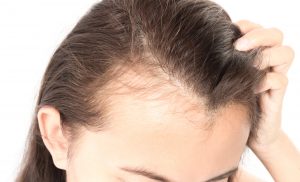Can Women Get PRP Hair Restoration?
 Hair loss is often thought of as a men’s issue, but the truth is that millions of women also struggle with thinning hair, bald spots, and receding hairlines. In fact, by age 50, about half of all women will experience hair loss in some way.
Hair loss is often thought of as a men’s issue, but the truth is that millions of women also struggle with thinning hair, bald spots, and receding hairlines. In fact, by age 50, about half of all women will experience hair loss in some way.
While there are many potential causes of women’s hair loss, from genetics to hormonal changes to stress, the emotional impact can be especially hard for women. Fortunately, there’s a new treatment that’s offering hope to women with thinning hair: PRP hair restoration.
What is PRP Hair Restoration?
PRP, or platelet-rich plasma, is a cutting-edge treatment that harnesses the power of your own body to stimulate hair growth. Here’s how it works:
- A small sample of your own blood is drawn at your appointment and placed in a centrifuge.
- The centrifuge spins at high speed, separating out the platelets and plasma from the other components.
- The concentrated platelet-rich plasma that is created is then injected into the scalp in the areas of hair loss.
- The growth factors found in PRP stimulate the hair follicles, encouraging growth and produce thicker, healthier hair.
PRP has been used for years in orthopedic medicine and dermatology to promote healing and anti-aging. Now, it’s showing promise as a natural, non-invasive treatment for hair loss in both men and women.
Is PRP Hair Restoration Right for Women?
While PRP hair restoration can be effective for both sexes, it can be an especially good option for women dealing with certain types of hair loss, such as:
Androgenetic Alopecia
This type of hair loss is also known as female pattern baldness, and is the most common type of hair loss in women. It is caused by a combination of both genetics and hormones. It can be somewhat different from male pattern baldness as it typically does not start with a receding hairline, but instead presents with a widening part or overall thinning of the hair.
Telogen Effluvium
This type of hair loss occurs when stress, such as a major illness, surgery, or even a strict diet, causes a larger than normal amount of hair follicles to enter the resting phase and shed their hair. PRP can help speed up the recovery process and encourage the follicles to start producing new hair.
Alopecia Areata
This autoimmune condition results in the body’s immune system attacking its own hair follicles, eventually leading to patchy hair loss on the scalp and other areas of the body. While there’s no cure for alopecia areata, PRP may help stimulate regrowth in affected areas.
What to Expect from PRP Hair Restoration
What’s great about PRP hair restoration is that it is minimally invasive, non-surgical, and effective. Each session takes approximately an hour and involves surprisingly little discomfort. There’s no downtime after the procedure, so you can return to your normal activities right away.
Results typically appear gradually over the course of several months, with maximum improvement seen around 6-12 months after the initial treatment series. Be aware that you may require several treatments and regular maintenance appointments to see maximum results.
While PRP hair restoration is generally safe and well-tolerated, it’s important to choose a reputable provider with experience performing the procedure on women.
Of course, every woman’s hair loss is unique, and not everyone will be a good candidate for PRP hair restoration. The best way to find out if it’s right for you is to schedule a consultation with an experienced provider who can assess your hair loss.
Get Fuller, Healthier Hair Now
If you’re a woman (or anyone) struggling with hair loss, you might not have to. If you’re ready to find out if PRP is right for you, we invite you to schedule a consultation with us today.



